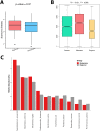Impact of the gut microbiome on response and toxicity to chemotherapy in advanced esophageal cancer
- PMID: 38984313
- PMCID: PMC11231538
- DOI: 10.1016/j.heliyon.2024.e32770
Impact of the gut microbiome on response and toxicity to chemotherapy in advanced esophageal cancer
Abstract
Objective: To identify the gut bacteria associated with chemotherapeutic outcomes, t characterized the gut microbiota in patients with esophageal squamous cell carcinoma (ESCC) in this prospective study.
Design: Thirty-one patients with ESCC were enrolled. Chemotherapy was performed with paclitaxel and cisplatin (TP). Fecal samples were collected before and after treatment and analyzed using 16S rRNA sequencing.
Results: The species with differences in baseline abundance between partial response (PR) and non-PR groups was identified as Bacteroides plebeius (P = 0.043). The baseline abundance of B. plebeius was higher in the responder (R, PR + stable disease (SD)) group (P = 0.045) than in the non-responder (NR). The abundance of B. ovatus was identified as a predictor for distinguishing patients with PR from those without PR (sensitivity, 83.3 %; specificity, 69.6 %). The abundance of B. plebeius was positively associated with the response to PR + SD (R) in predicting responders in the receiver operating characteristic (ROC) curve analysis (area under the ROC curve = 0.865, P = 0.041). The abundance of B. plebeius and B.uniform was a predictor of grade (G) 3-4 chemotherapy toxicities. The sensitivity and specificity of the established multi-analyte microbial predictive model demonstrated a better predictive ability than a single parameter (B. uniform or B. plebeius).
Conclusion: The abundance of gut microbiota B. plebeius and B. ovatus are associated with the efficacy of TP chemotherapy in patients with ESCC. The abundance of B. plebeius and B.uniform may related to the toxicity of TP chemotherapy.
Keywords: Chemotherapy; Efficacy; Esophageal squamous cell carcinoma; Gut microbiota; Toxicity.
© 2024 The Authors.
Conflict of interest statement
The authors declare that they have no known competing financial interests or personal relationships that could have appeared to influence the work reported in this paper.
Figures





References
-
- Li Ningning, Gao Liwei, Ge Yuping, Lin Zhao, Bai Chunmei, Wang Yingyi. Prognostic and predictive significance of circulating biomarkers in patients with advanced upper gastrointestinal cancer undergoing systemic chemotherapy. Front. Oncol. 2023;13 doi: 10.3389/fonc.2023.1195848. eCollection. - DOI - PMC - PubMed
LinkOut - more resources
Full Text Sources
Research Materials

